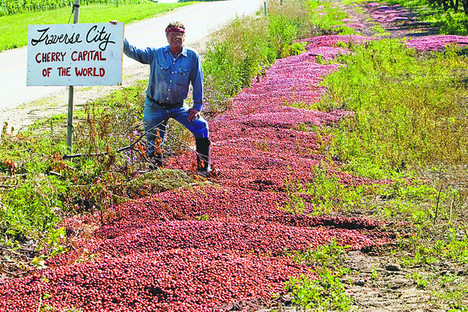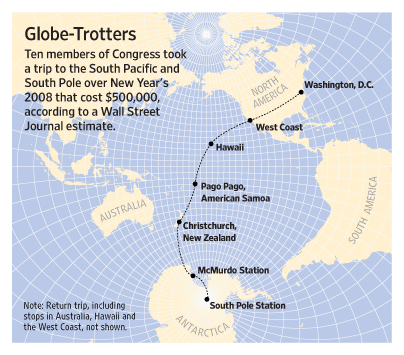 “Leonard Ligon, a farmer near Traverse City, Mich., stands in mounds of tart cherries that he had to dump because of a price-stabilization program. Mr. Ligon says he discarded 72,000 pounds of the crop.” Source of photo and caption: online version of the WSJ article quoted and cited below.
“Leonard Ligon, a farmer near Traverse City, Mich., stands in mounds of tart cherries that he had to dump because of a price-stabilization program. Mr. Ligon says he discarded 72,000 pounds of the crop.” Source of photo and caption: online version of the WSJ article quoted and cited below.
(p. A5) Farmers in Michigan and six other states are harvesting a bumper crop of tart cherries. But the bounty is turning out to be the pits for farmers whose fruit is rotting in orchards instead of bubbling in cherry pies.
Under a Depression-era federal program designed to keep prices from plummeting, tart-cherry farmers are being told by fruit processors to leave up to 40% of their crop unharvested.
“It’s kind of heartbreaking,” said Rob Manigold, a tart-cherry farmer near Traverse City, Mich. Michigan grows about 75% of all the tart cherries in the U.S.
. . .
The tart-cherry industry operates under a government-sanctioned plan called a federal marketing order that dates to 1933. It allows farmers and processors to legally regulate supply to keep prices stable. Other commodities that operate under similar programs include some types of dates, olives and kiwifruit.
. . .
This year, the industry board, a 18-member panel of growers and processors, determined that there were more than enough cherries in the fields to satisfy demand and to replenish the reserves. So the board limited how much processors can put on the market in the U.S. That leaves farmers with cherries they can’t sell and are left to rot.
Bern Kroupa, a 61-year-old fruit farmer outside Traverse City in Michigan’s northern lower peninsula, said this year he is going to let about a quarter of his crop — about 500,000 pounds — rot.
. . .
Leonard Ligon, another tart-cherry grower near Traverse City, Mich., generated a lot of local press last week when he dumped 72,000 pounds of cherries alongside a country road on his farm. “I wanted to make the public aware of the plight of the tart-cherry farmer,” he said. “I could call it a mulch pile.”
For the full story, see:
LAUREN ETTER. “Bumper Cherry Crop Turns Sour; Tons of Unharvested Fruit Rots Under Government Program to Keep Prices Stable.” The Wall Street Journal (Sat., AUGUST 22, 2009): A5.
(Note: ellipses added.)




